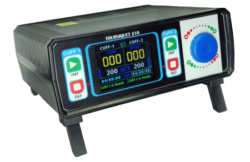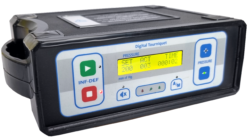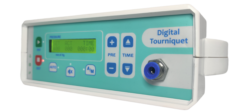A digital tourniquet machine is a medical device used to temporarily restrict blood flow to a specific part of the body during surgical procedures, medical treatments, or to manage traumatic injuries. The primary purpose of a tourniquet is to control or minimize bleeding in a controlled manner, making it easier for healthcare professionals to perform procedures or surgery while maintaining a clear field of vision and minimizing blood loss.
Here are some key features and functions of a digital tourniquet machine:
- Digital Control: Unlike traditional tourniquets, digital tourniquet machines are equipped with electronic controls and display screens. This allows for precise and adjustable pressure control.
- Pressure Control: Healthcare professionals can set and monitor the pressure applied to the tourniquet cuff using digital controls. This precision is essential to avoid over-tightening, which can lead to tissue damage, or under-tightening, which may not provide adequate blood flow restriction.
- Safety Features: These devices often come with safety features to prevent over-inflation and to provide alarms or alerts if there are issues with the tourniquet pressure.
- Multiple Cuff Options: Digital tourniquet machines typically support various cuff sizes and designs to accommodate different body parts, such as limbs or fingers.
- Battery or Electric-Powered: Digital tourniquets can be battery-powered or connected to an electrical source, offering flexibility for different clinical settings.
- User-Friendly Interface: The interface on the digital tourniquet machine is designed to be user-friendly, making it easy for healthcare professionals to set and adjust the pressure levels.
- Single-Use or Reusable Cuffs: Some machines use disposable cuffs for single-use, while others have reusable cuffs that can be sterilized between uses.
Digital tourniquet machines are used in various medical fields, including orthopedic surgery, vascular surgery, and emergency medicine. It’s important to use them with care and expertise, as improper application can lead to complications, such as tissue damage or nerve injury. Proper training and adherence to clinical guidelines are essential for the safe and effective use of digital tourniquet machines.
Digital Tourniquet System
Digital Tourniquet System
Digital Tourniquet System







